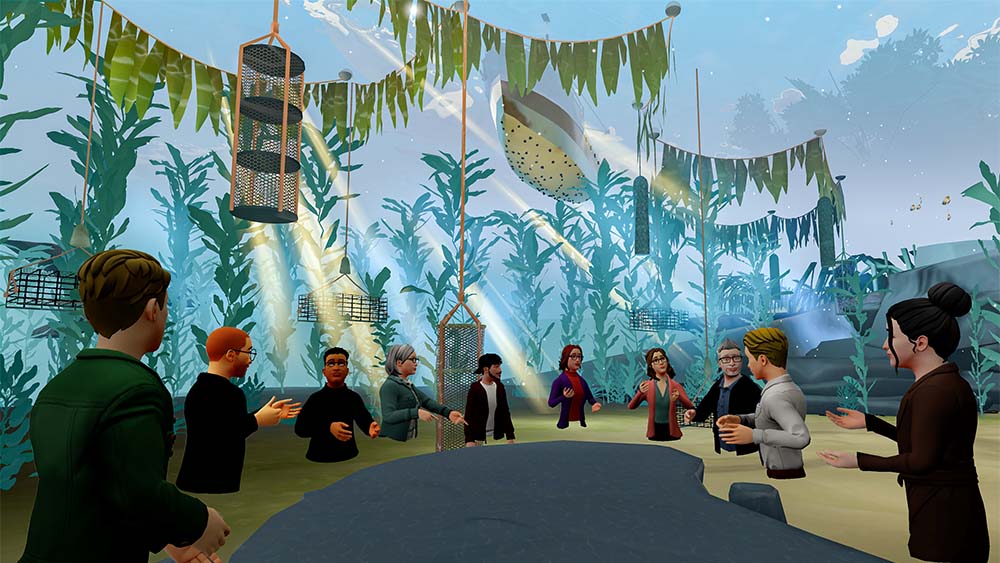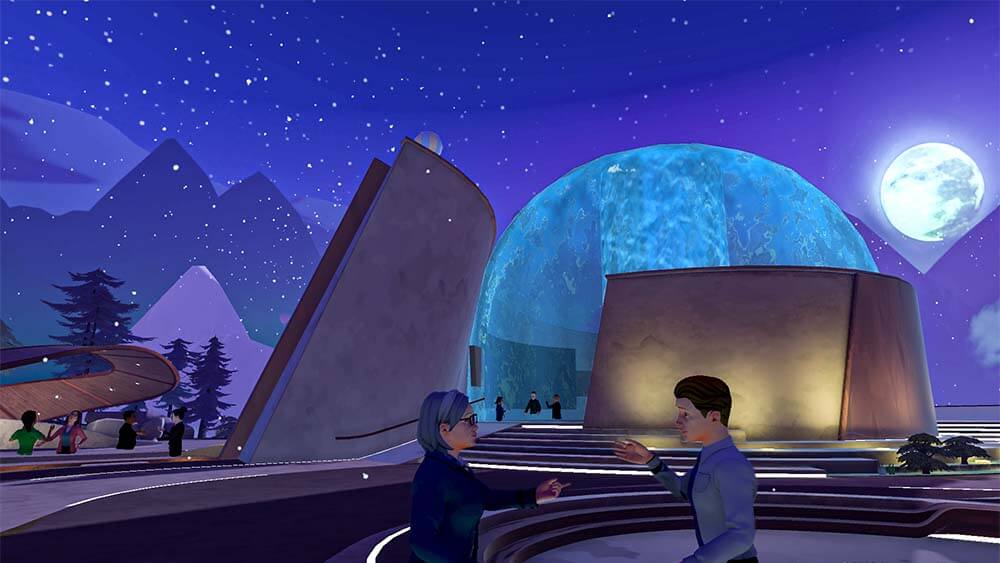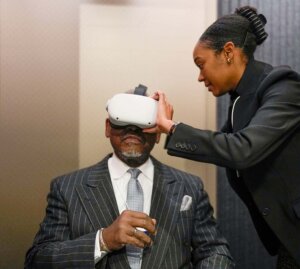
World Economic Forum Annual Meeting participants met at the underwater table in the Kelp Conference Room in the Global Collaboration Village. (Courtesy of Accenture)
Convene editors gathered ideas and insights from a variety of sources to examine what the metaverse is and how business events professionals are and will be using it in the future. This is one in a series of stories (see list at bottom) from the March/April issue of Convene.
For decades now, the World Economic Forum (WEF) has convened its Annual Meeting in the mountain-capped Swiss town of Davos-Klosters, drawing leaders from governments, NGOs, and industry the world over to discuss the most pressing matters of the day, from climate change to cybersecurity and everything in between. This past January, WEF expanded its Annual Meeting beyond the Alps into the virtual universe with the Global Collaboration Village. This metaverse experience sought to add a new dimension to the meeting as well as lay the groundwork for reaching a wider audience — fitting, given this year’s conference theme: “Cooperation in a Fragmented World.”
Collaborating with Accenture and Microsoft, WEF built a prototype of the Village using Microsoft Mesh, a new mixed-reality platform designed specifically for shared experiences — Microsoft is currently building that same technology into Teams. On site at WEF’s Annual Meeting, attendees could don VR headsets to explore the platform, but it’s also designed to be accessed by a laptop. WEF drew inspiration from its Annual Meeting’s real-life campus in Davos to build out the Global Collaboration Village, featuring a variety of environments for gathering, storytelling, and experiential learning. It’s also organized by five themed collaborative centers — Economic and Social Policies, Nature and Climate, Global and Regional Cooperation, Industry Transformation, and the Fourth Industrial Revolution — inspired by WEF’s own focused areas of content.

Kelly Ommundsen
One of the most thoroughly built-out centers is focused on oceans, where attendees can take a deep dive into the depths — literally and figuratively — starting with a hot-air balloon ride over a Spilhaus projection map, which shows the world’s oceans as one body of water. From there, an “aqua-lift” — an ocean elevator — takes them under the sea where they can learn about aquaculture and sustainable blue foods, explore coral reef systems, and meet with other attendees around an under- water table in the Kelp Conference Room.
“What’s amazing is that it adds the element of play, and gets people out of their traditional mindset,” Kelly Ommundsen, WEF’s chief of staff, head of Global Collaboration Village, told Convene. Ommundsen sees great potential in the metaverse when compared with typical video conferencing platforms, because “[it] offers a much more fit-for- purpose tool,” she said. “You have the ability to add in that immersive learning and you’re able to connect in more co-present and meaningful ways.”
WEF experimented with this potential during the 2023 meeting, hosting a session about sustainable seafood practices that organizers say is the first time a conference has held a multilateral session in the metaverse. Held in the Kelp Conference Room, with ocean flora and fauna floating all around, the session illustrated how the metaverse can add a deeper, more interactive layer of mean- ing to the virtual meeting experience. “We can talk to you about blue food,” Ommundsen said, “or we could show you what a polyculture under the water looks like.”

The Village’s Town Hall will be built out over the next few years. (Courtesy of Accenture)
A Whole New World
As the world has navigated virtual meeting spaces more frequently over the past few years, a major drawback has emerged — the loss of serendipitous encounters. But in the metaverse, that possibility re-emerges. Ommundsen shared that during a session, two negotiators happened to virtually bump into each other while attending a demo in the Village’s oceans center, which evolved into them having an impromptu meeting and eventually realizing that the setting could work well for their future negotiations. Ommundsen emphasized that WEF is being intentional about how to design the experience for this kind of serendipity, “because we all know that’s one of the best parts [of WEF’s Annual Meeting] — it’s not just the people you know, it’s the ones you bump into at the coffee machine,” she said.

Participants on site could wear VR headsets or use laptops to explore the Village. (Valeriano Di Domenico)
The 2023 edition of the Global Collaboration Village is “just a slice” of what WEF plans to build out over the next few years. For example, the Town Hall will eventually serve as a gathering focal point for the Village, where other organizations can build out their own virtual pavilion for meetings, showcases, and education. WEF had more than 80 founding Village partners this year, which included global organizations like the American Heart Association and dozens of companies across multiple sectors, from Sony to Salesforce.
“We really want to ensure that [the Village] is community driven,” said Ommundsen, who added that the 80 founding partners have given meaningful input and feedback, providing insight on what it’s like for a larger group to work in the metaverse. “We want to understand how people want to use the metaverse, what’s valuable, and how should we prioritize what we’re going to build first.” She envisions the Village eventually evolving into a multipurpose space used throughout the year, where board meetings can be held alongside cultural events.
Accenture estimates that, by 2025, the metaverse will influence $1 trillion in revenue in the private sector. So far, companies like Gucci and Nike have demonstrated the metaverse’s potential for commerce with their successful marketplaces, while others have tapped it for enterprise and industrial solutions. But WEF claims to be among the first to attempt to leverage this immersive platform for public purpose. “The fourth use is really about how to use the metaverse to solve big problems,” Julie Sweet, chair and CEO of Accenture, said during a press conference at Davos. “The metaverse … is successful because it serves two purposes — it serves human need and it creates something that doesn’t exist today, the interaction of the digital and virtual world where we can experience it together. The metaverse allows you to immerse, to have greater learning, and have an experience that can’t be done because everybody can’t be brought to places like the bottom of the ocean.”
Jennifer N. Dienst is senior editor at Convene.
ON THE WEB
To view the WEF press conference on the Global Collaboration Village held during Davos, visit weforum.org.

The Complete March/April CMP Series
- Meeting in the Metaverse
- The Metaverse and Events, According to ChatGPT
- What Exactly Is the Metaverse? Here’s One Expert’s Take.
- A Virtual Tour Through Atlanta’s Convention Offerings
- Un-Remote Work in the Metaverse
- How the Metaverse Can Solve the Limitations of Physical Events
Earn one clock hour of CMP certification by visiting the Convene CMP Series page to answer questions about these stories. The Certified Meeting Professional (CMP) is a registered trademark of the Events Industry Council.
